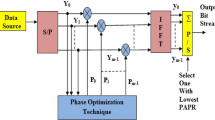Abstract
This paper investigates the problem of dynamic subcarrier and bit allocation in downlink of Multiple Input Multiple Output (MIMO) Orthogonal Frequency Division Multiple Access (OFDMA) Systems. Using Singular Value Decomposition, the MIMO fading channel of each subcarrier is transformed into an equivalent bank of parallel Single Input Single Output sub-channels. To achieve the capacity bound, one must solve a multiuser subcarrier allocation and the optimal bit allocation jointly. To alleviate the computational complexity of joint subcarrier and bit allocation, several suboptimal solutions have been proposed. These suboptimal solutions handle subcarrier and bits individually. We propose the use of Non-dominated Sorting Genetic Algorithm (NSGA)-II, which is a multi-objective Genetic Algorithm, for joint allocation of bits and subcarriers, in the downlink of MIMO-OFDMA system. NSGA-II is intended for optimization problems involving multiple conflicting objectives. Here the two conflicting objectives are Rate Maximization and Transmit Power Minimization. The simulation results indicate remarkable improvement in terms of convergence over previous approaches involving Evolutionary algorithms. At the same time capacity achieved by the proposed algorithm is found to be comparable with that of previous algorithms.




Similar content being viewed by others
References
Wong, C. Y., Cheng, R. S., Letaief, K. B., & Murch, R. D. (1999). Multiuser OFDM with adaptive subcarrier, bit, and power allocation. IEEE Journal of Selected Areas in Communication, 17(10), 1747–1758.
Rhee, W. & Cioffi, J. M. (2000). Increasing in capacity of multiuser OFDM system using dynamic subchannel allocation. In Proceedings of IEEE international vehicular technology conference (Vol. 2, pp. 1085–1089).
Jang, J., & Lee, K. B. (2003). Transmit power adaptation for multiuser OFDM system. IEEE Journal of Selected Areas in Communication, 21, 171–178.
Shen, Z., Andrews, J. G., & Evans, B. L. (2005). Adaptive resource allocation in multiuser OFDM systems with proportional rate constraints. IEEE Transactions on Wireless Communications, 4(6), 2726–2737.
Zhang, Y. J. K., & Letaief, B. (2005). An efficient resource-allocation scheme for spatial multiuser access in MIMO/OFDM systems. IEEE Transactions on Communication, 53(1), 107–116.
Xiao, X., Hu, Z., Zhu, G. & Li, L. (2005). Adaptive subcarrier allocation for increasing the capacity of multiuser spatial multiplexing based OFDM systems. In Proceedings of IEEE PIMRC, Berlin, Germany (pp. 377–381).
Hu, Y., Yin, C., & Yue, G. (2006). Multiuser MIMO-OFDM with adaptive antenna and subcarrier allocation. In Proceedings of IEEE VTC-2006 Spring. Melbourne, Australia, pp. 2873–2877.
Guan, Z.-J., Li, H., Xu, C.-Q., Zhou, X.-L., & Zhang, W.-J. (2009). Adaptive subcarrier allocation for MIMO-OFDMA wireless systems using Hungarian method. J Shanghai University (English Edition), 13(2), 146–149.
Kim, I., Park, I.-S., & Lee, Y. H. (2006). Use of linear programming for dynamic subcarrier and bit allocation in multiuser OFDM. IEEE Transactions on Vehicular Technology, 55(4), 1195–1207.
Wong, C. Y., Cheng, R. S., Lataief, K. B., & Murch, R. D. (1999). Multiuser OFDM system with adaptive subcarrier, bit and power allocation. IEEE Journal of Selected Areas in Communication, 17, 1747–1758.
Reddy, Y. B. (2007) Genetic algorithm approach for adaptive subcarrier, bit, and power allocation. In Proceedings of the IEEE international conference in networking, sensing and control, London, UK.
Zhihua, T., Youtuan, Z., Guo, W., & Jinkang, Z. (2007). Cross-layer resource allocation for multiuser OFDM systems based on ESGA. In Proceedings of IEEE vehicular technology conference (VTC 2007—Fall), Baltimore, MD, USA.
Zhihua, T., Youtuan, Z., Guo, W., & Jinkang, Z. (2008). An elitist selection adaptive genetic algorithm for resource allocation in multiuser packet-based OFDM Systems. Journal of Communication. Academy Publishers, Finland.
Sharma, N., Rao, A., Dewan, A., & Safdari, M. (2008). Rate adaptive resource allocation for multiuser OFDM using NSGA-II. In Proceedings of IEEE conference on wireless communication and sensor networks (WCSN-2008), IIITA and DAVV, Indore.
Kalyanmoy, D., Amrit, P., Sameer, A., & Meyrivan, T. (2002). A fast and elitist multi-objective genetic algorithm: NSGA-II. IEEE Transactions on Evolutionary Computation, 6(2), 182–197.
Andersen, J. B. (2000). Array gain and capacity far known random channels with multiple elements arrays at both ends. IEEE Journal of Selected Areas in Communication, 18(2), 2172–2178.
Reddy, Y. B., & Gajendar, N. (2007). Computationally efficient resource allocation in OFDM Systems: Genetic algorithm approach. In Proceedings of the 4th international conference on information technology: New generations (ITNG 2007), Las Vegas, Nevada, USA.
Kalyanmoy, D. (2001). Multi-objective optimization using evolutionary algorithms (1st ed.). USA: Wiley.
Lance, C. (Ed.). (1995). Practical handbook of genetic algorithms, Vol. 1. USA: CRC Press.
David, E. G. (1989). Genetic algorithms in search, optimization and machine learning. Boston, MA: Kluwer Academic Publishers.
Cox, E. (2005). Fuzzy modeling and genetic algorithms for data mining and exploration. USA: Elsevier.
Srinivas, N., & Deb, K. (1995). Multi-objective function optimization using non-dominated sorting genetic algorithms. Evolutionary Computation, 2, 221–248.
Author information
Authors and Affiliations
Corresponding author
Rights and permissions
About this article
Cite this article
Sharma, N., Anupama, K.R. On the use of NSGA-II for multi-objective resource allocation in MIMO-OFDMA systems. Wireless Netw 17, 1191–1201 (2011). https://doi.org/10.1007/s11276-011-0340-0
Published:
Issue Date:
DOI: https://doi.org/10.1007/s11276-011-0340-0




